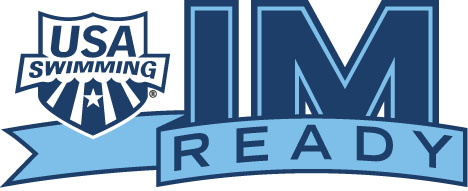IMX AND POWER POINTS
To calculate scores for each age group, swimmers receive power points from each of their swims. Those points are then tallied, and the swimmer with the most points, wins! Read up on the programs below and get started today.
Oh, and you’ll need a Deck Pass account – it’s free, and easy, so sign up now!
An IMX or IM Ready score is only established after a swimmer has swum all of the events required for their age group in a sanctioned meet since the start of the current season; both short and long course seasons start September 1 and end August 31 for IMX/IMR purposes.
Additionally, a swimmer must complete all of the events in the same course (SCY or LCM) to have a score in that particular course.

IM READY (IMR)
The first step in the IMX Challenge is IM Ready (or IMR). To get "IM Ready," swimmers compete in a series of five events at shorter distances. Below, we've listed the line-up by age groups.
9 & Under; 10-year olds: 100 Free, 50 Back, 50 Breast, 50 Fly, 100 IM (SC) or 200 IM (LC)
11-year olds; 12-year olds: 200 Free, 50 Back, 50 Breast, 50 Fly, 100 IM (SC) or 200 IM (LC)
13, 14, 15, 16, 17, & 18-year olds: 200 Free, 100 Back, 100 Breast, 100 Fly, 200 IM
Once you've swum each event at least once at an official meet, you can log-in to your Deck Pass Account, and find out where you rank against all the other swimmers on your club team. You do not need to complete the IMReady program to participate in the IM Xtreme. It is simply a stepping stone.

IM XTREME (IMX)
Ready to move forward? The next step is IM Xtreme (IMX). The IMX ranking includes a series of five or six events at longer distances. Once you've completed the IMX program, you can find out where your IMX score ranks nationally, within your zone, within your LSC rank and on your club.
9 & Under; 10-year olds: 200 Free, 100 Back, 100 Breast, 100 Fly, 200 IM
11-year olds; 12-year olds: 400 Free (LC) or 500 Free (SC), 100 Back, 100 Breast, 100 Fly, 200 IM
13, 14, 15, 16, 17, & 18-year olds: 400 Free (LC) or 500 Free (SC), 200 Back, 200 Breast, 200 Fly, 200 IM, 400 IM
HOW DO I SCORE POINTS?
Rankings in the program are based on power points, a system developed by USA Swimming and Hy-Tek. See the Power Points page on www.usaswimming.org for more information and to use the Power Point Calculator.
HOW DO I PARTICIPATE?
Participation in the IMR and IMX is easy. USA Swimming automatically scores and calculates results for all athlete members! Swimmers only need to sign up for a Deck Pass Account, then compete in each required event, at a sanctioned meet, at least once in a season.
COACHES' IMX LISTING
A coach can see a listing of his/her team’s IMR and IMX Scores through the coach’s Deck Pass page. Access is through the coach’s personal website account.
Swimmers have the option of printing certificates that displays their scores for either IMR or IMX. They can also optionally print their national, zone, LSC and/or club rankings.
Hy-Tek Power Points in the SWIMS Times Database
Every swim listed in the USA Swimming SWIMS Times Database includes a Hy-Tek Power Point value. Working in collaboration with USA Swimming, Hy-Tek has developed a power point system for each age level that assigns a point value to each swim. This point system allows for comparison of the quality of performances across strokes, distances and events, as well as between age groups.
About Hy-Tek Power Points:
- The power point scale ranges from 1 to 1100 points with 800 points closely approximating the old National Reportable Time Standard (this time standard is no longer published).
- The point system has been created using an algorithm that is adjusted slightly for each age level. Ideally, a 500 point swim at one age level is equal in quality to a 500 point swim at another age level.
- The point system will not be changed from year to year unless there is a rule change that would create a sudden time change for an event or stroke (example: the rule whereby a swimmer can not swim past 15 meters underwater).
- Hy-Tek Power Points are independent of any other power point systems currently in use (FINA power points, high school power point tables, etc.)
Specific USA Swimming Uses for Hy-Tek Power Points: These power point tables are utilized in three USA Swimming Club Recognition programs:
Other Potential Uses for Hy-Tek Power Points:
- To assess strengths between distances in the same stroke. For example, a swimmer can compare his/her point score in the 100 Back vs. the 200 Back or across several freestyle distances such as the 100, 200, and 400.
- Swimmers can look at the relative strength of one stroke vs. another stroke, i.e. freestyle compared to breaststroke.
- To determine the quality of short course vs. long course swims. This comparison is a great way for an athlete to measure progress from the end of the short course season through the long course season.
- Coaches and clubs can use combined power points (perhaps in a certain set of events) as one of their requirements for promotion to higher level practice groups.
- Provides coaches a tool to evaluate relative performance over different maturation periods (i.e. 11-12 boys vs. 13-14 boys or 11-12 girls).
- Allow coaches to evaluate effectiveness of training or taper by looking at point improvement across different strokes and distances.
- Facilitates fun intrasquad competitions between age groups in a club program, i.e. 11-12 girls vs. 15-16 boys. 200 Free results can be ranked by points as opposed to times.
- There are several different ways that power points can be used to determine High Point Awards at a swim meet.
- Meet hosts might use power points as another way to score team points at a swim meet.
- With power points, coaches can award a “Performance of the Meet” (highest point score) or “Most Improved Swim” (greatest number of points improvement) or similar type acknowledgements after each swim meet.
Coaches and clubs can use power points in a variety of ways to recognize and acknowledge swimmers at season-ending award ceremonies.
- LSC’s can use power points as a tool to assess relative strengths in establishing time standards for different levels of meets. Both clubs and LSC’s might use combined points to serve as another way to qualify for participation in certain meets.
IMR, IMX & Power Point Calculator (includes Hy-Tek Power Point Tables): A swimmer can calculate his or her power point score instantly by using the IMR, IMX & Power Point calculator. A swimmer selects his event and age, enters his time into the calculator and then clicks on the Calculate button. A swimmer also has the option of looking at and printing the chart of all point values from 2 to 1,100 with corresponding times for the selected event. These tables make it possible to look at specific events and research the point value assigned to various times for that event. Note: All 8-under athletes use the 9 yr old scores.
It is our belief that power points will prove to be a valuable measurement tool for swimmers and coaches as well as other segments of the swimming world. We hope you enjoy this new addition to the USA Swimming SWIMS Times database.
We want to thank Charlie Hodgson and our friends at Hy-Tek for their assistance in developing the power point system and for allowing USA Swimming to use the point system with our SWIMS Times database.



